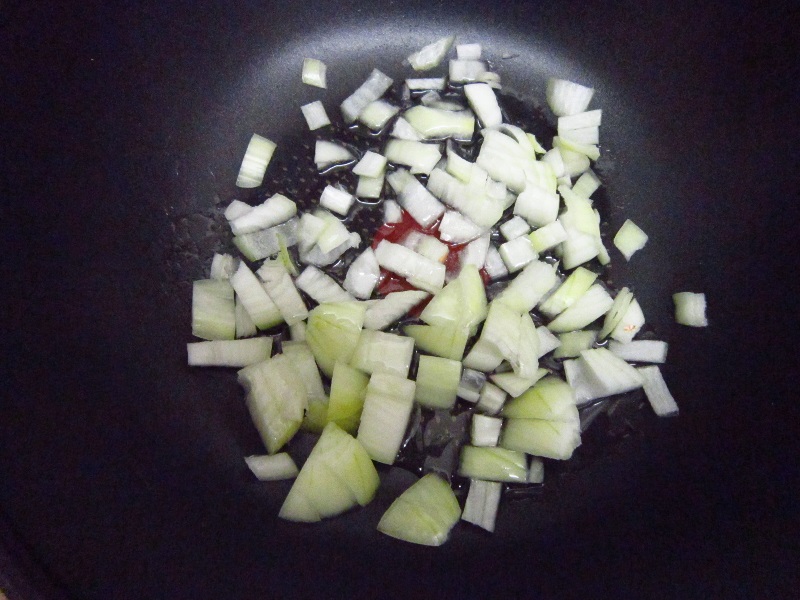Quorn Bolognese
Filed Under: Food

I took a whole bunch of photos one time I was making dinner about four months ago, when I still lived in Dundee. All of them have been sitting in a folder on my hard drive since then, untouched and unused, just like any other dumb blog post idea I get halfway through executing and then forget or fail to finish. At long last, however, here it is: the photographically-illustrated recipe I braved the bemused comments of my old flatmate for. “Why are you taking photos of your food?” he asked, as I pointed my mediocre digital camera into a steamy saucepan. I opened my mouth to speak, but couldn’t answer his question. Why do I do these things? So that YOU, dear reader, can learn how to make some reasonably okay faux-Bolognese using Quorn instead of beef? Or because deep inside of me there is a darkness waiting to emerge, a great ink blot from the deepest recesses of my soul, and I believe it is only through filling the void with frivolous ‘creative’ activities that I can prevent it rising to the surface?
To be honest, it’s more of a list of suggestions than a recipe, because I tend to just chuck whatever I happen to have into most things I cook and, usually, it turns out okay. Hopefully the main takeaway from this will be that yeah, you can just make regular old straightforward and wholesome meals using Quorn, that it’s easy to cook with, and usually cheaper than meat.
Ingredients
There’ll be no quantities here. Use your intuition. You’re gonna need/want:
- An onion
- An carrot
- An’ some celery
- Garlic, be it freshly crushed or chopped or in the form of dry granules – you do you
- Other things? I don’t know?
- A big ol’ saucepan or something like that. Whatever it is, it needs to be able to go on the stove without catching fire or cracking or melting or food spilling over the sides. You probably have at least one item in your kitchen which will satisfy these criteria.
And some of this stuff:

Last time I was in Lidl you could buy this stuff from the freezer section for less than £2. If it’s more than that now, then probably Brexit is to blame? It’s easy to stock up on, can be kept in the freezer for whenever you need it, and you don’t even need to defrost it before cooking. Ideal!
The future is fungal, baby1.
How to Cook the Thing
Firstly just generally get your mise on. Chop up your onion and your other vegetables. Get all your things ready. Take a few deep breaths. Offer up thanks to the mushroom god. Savour the moment.
Now it’s onion time.

Put a bit of olive oil in the pan and set it on a medium-to-low heat. Once the oil’s warmed up, chuck in the chopped onion. Stir a bit as the onion cooks, going from pale to semi-translucent, so it doesn’t burn and get stuck to the bottom of the pan. This’ll take maybe only two minutes, depending on the heat. You might want to add a few drops of apple cider vinegar, which brings out the sweetness and smells amazing as it evaporates2.
Once the onion’s cooked is when I usually add the Quorn. Dispense that frosty fungus into the pan and keep turning it over as it thaws in the heat.

Now that it’s defrosted, I add the chopped tomatoes and/or purée. Tomato is a pretty key ingredient for Bolognese. Stick it in, stir it up.

We’re now entering the Season, Sprinkle and Simmer phase of the Sauce Development Pipeline. You may add seasoning like salt and pepper, but I usually skip the salt and just use a bit of pepper. Sprinkle a generous amount of oregano and basil into the pan.
Add any other vegetables you might want to add like, in this case, carrot and celery (both great ways to bulk up any meal!).

This is the bit where I’ll say that, while the sauce will turn out just fine without very small bits of animal in it, if you’re not particularly ideologically pure like me then you could add a beef stock cube or dash of Worcestershire Sauce for a meatier, richer body. As I see it, just because it’s Quorn doesn’t mean it has to be a totally vegetarian recipe. It’s up to you!
The carrots will need at least 15 minutes to soften up and as a whole the sauce needs time for all the flavours to mix together, so add a little water, stick the lid on and let it simmer for, well, as long as you’d like. Go and read a book. Come back occasionally to stir it and make sure it’s not sticking to the bottom of the pan.
I like to add frozen garden peas or petits pois like 3 minutes from the end, giving them enough time to thaw out and warm up. They add a little variety.
Once everything’s nice and softened up and saucy (thick, with not too much loose water sloshing around), your Quorn Bolognese is now ready to eat, with pasta or whatever. Enjoy it, and thanks for reading!